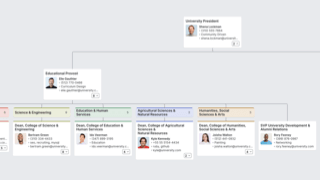University Organizational Chart Template
Check out our interactive university org chart below to see how higher educational institutions organize their departments. We've also provided common hierarchies found in university admin departments, plus descriptions for top roles typically found in larger universities.
Build Your Org ChartReady to get started?
Download the University org chart template above, add your own employee data, and Import into Pingboard. Note: you’ll need a Pingboard account first. Sign up for a free trial.
Pro Tip You can build your org chart automatically. Instead of filling out a spreadsheet, you can connect your HR system to Pingboard to automatically sync employee data. Your org chart will get updated automatically every time a change happens. We integrate with ADP, Azure, BambooHR, Google Apps, Namely, Okta, and more.
University Hierarchy
Here are the roles typically found in the hierarchy of a college’s educational department. We’ve outlined the organizational structure of a business department for this example.
University President
The University President is the Chief Executive and Administrative Officer for the Board of Directors. The President is typically involved in a number of high-level administrative decisions like budgets, staffing, fundraising, and being involved in relevant local, state, and federal governmental agencies. In addition to these overarching responsibilities, here are a few specific tasks that university Presidents are responsible for:
- Providing effective leadership and support for all academic programs to align all administrative and educational departments with the University's mission
- Acting as the chief spokesperson for the college
- Building an annual budget and presenting it to the Board
- Providing policy recommendations to the Board on all matters that affect the University.
- Overseeing that all facilities are maintained
Provost/Vice President for Academic Affairs
A university’s Provost is the Chief Academic Officer and provides leadership to all academic areas to help departments reflect the mission of the institution. The Provost provides leadership and guidance to faculty and academic staff to ensure consistency of curriculum and academic programs. In addition to these general responsibilities, here are a few specific tasks that a Provost would handle:
- Coordinating with the College Deans to approve the hiring, support, development, and evaluation of faculty, staff, and administrators of instructional programs and services
- Supporting and encouraging research, grant-writing, publishing, and other scholarly activities of the faculty
- Organizing accreditation efforts and the preparation of reports to various accrediting agencies for department heads
- Leading efforts to recruit and retain distinguished professors and researchers with a focus on increasing diversity amongst the educational staff
- Working with administrators and faculty to add innovative academic programs, both traditional and online, with the goal of increasing student enrollment and reach
Dean of a College or Department
Each dean is part of the University’s executive staff and is responsible for promoting academic, administrative, and fiscal leadership across their department. Deans are responsible for establishing and tracking the goals and objectives of their department to ensure they are in line with the university’s mission. Deans are also responsible for these things:
- Conducting school operations in accordance with: federal and state laws and regulations, college policies and procedures, contractual agreements, and accreditation standards
- Working with each professor across the department to develop and sign off on their curriculum
- Effectively communicating information, plans, and projects with all constituents
- Supporting the faculty via mentoring, as well as identifying talented faculty and cultivating their skills for leadership roles within their discipline or beyond
- Promoting the College’s students to add value to organizations through internships, projects, and full-time employment
Associate Dean
Most Associate Deans are responsible for oversight and coordination of all the programs and activities that support student recruitment, education, and retention in the college or department. They assist the dea with information dissemination to students, test administration, facilitating student employment processes, student orientation coordination, and student behavioral interventions. In addition to these general responsibilities, here are a few other things Associate Deans typically handle:
- Evaluating and overseeing the definition of professional development plans and goals for staff in accordance with good management practices, campus policies, and college bargaining agreements
- Hiring, evaluating, training, disciplining, and recommending the dismissal of staff as necessary
- Ensuring that all curriculum-related elements are ready, appropriate, and are of sufficiently high quality for accreditation as needed to meet various deadlines for accreditation
- Representing the Dean at some events
- Assisting the Dean in accreditation functions like document creation, data collection, data entry, education of faculty, and other accreditation-related functions
Department Head
The last rung in this university hierarchy is the department head, and for this example we’ll be looking at responsibilities. Department heads exercise leadership, demonstrate vision and empower others to execute an agreed-upon departmental strategy. Since people in this role are experts in their field, and they are responsible for ensuring the department's strategy is aligned with that of the broader educational institution, it’s up to them to communicate the focus of their curricula (across the department) to the university’s educational executives. In addition to these general responsibilities, here are other things the department head does:
- Working with the Dean on curriculum coordination, admissions, registration, student database maintenance, textbook ordering, and graduation activities.
- Preparing annual departmental reports describing the department's accomplishments in research and scholarship, the fulfillment of the university's educational mission, fundraising, alumni engagement, and other topics
- Developing and refreshing programs to attract new students
- Managing faculty and staff performance evaluations
- Determining the department's necessary budget on an annual basis and requesting it from the overall university or college
